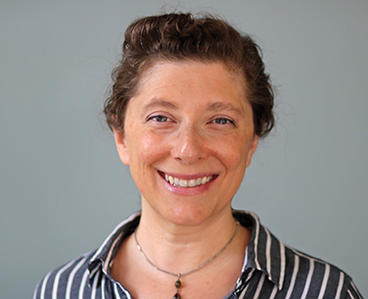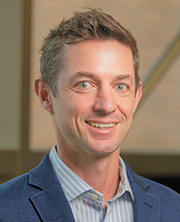Human-trafficking networks targeted in new research
Results will be used to impact policy that aims to break up these networks
April 7, 2021
Paul Along
Terry Forliti helps sex-trafficking survivors find a different life, but she knows what it’s like to be on the other side, caught in a spell of addiction and homelessness while grasping the bars of a jail cell.
Forliti, sober since 2008 and now the executive director of Breaking Free in St. Paul, Minnesota, is using her past in a partnership with researchers to find new ways of breaking up sex-trafficking networks.

Those researchers include School of Nursing Associate Professor Lauren Martin, PhD, who is the principal investigator on a new, National Institute of Justice-funded project to develop models aimed at giving researchers, law enforcement and policymakers a bird’s eye view of how sex-trafficking networks operate.
“I think good policy is based on good data, and we don’t have good data yet about sex trafficking networks and operations, because people engaged in trafficking go to great lengths to keep it hidden,” says Martin. “I think in the anti-trafficking movement, the interventions that are most common are the ones that are in a way the most proximal or easiest to envision. But we don’t have good data on if those interventions, like arresting a trafficker, actually changes the landscape.”
Martin and her collaborators are drawing from law enforcement case files, stakeholder interviews and guidance from sex-trafficking survivors, including Forliti, to gather data on trafficking.
Forliti said she and other members of the advisory group looked at early versions of a model and thought about their own stories to help refine it. Talking with the research team also helped the survivors shine a new light on their experiences and process them, she says.
“In this dynamic, we try to figure out where this power and control came from, how it was used and at what points in the grooming, initiation and enslavement it happened,” Forliti says. “This is the stuff we can answer. These are things, if you haven’t been through it, you don’t know. That’s what I want people to ask.”
Research partnership forged with interdisciplinary intention
Martin uses qualitative, mixed-methods and collaborative research rooted in strengths, assets, meaning-making and experience to highlight the ways that sex trading is a critical community health challenge.
“I think the School of Nursing is a great home for this work because while we’re talking about law enforcement, trafficking models and operations, when we boil it down, it is about wellness and about how we create conditions where people can thrive,” says Martin. “How do we promote wellness, healing, health and stability for people who are at risk of trafficking or who have been involved in trafficking?”
Outside of academia, the multi-institution research team is advised by a group of experts on human-trafficking networks, including Forliti, representatives from The Family Partnership’s PRIDE program, several independent survivor-consultants and a law enforcement task force.
Martin is collaborating on the research with Tom Sharkey, an industrial engineering professor from Clemson University; Yongjia Song, assistant professor of industrial engineering at Clemson; Kayse Maass, an assistant professor of mechanical and industrial engineering at Northeastern University; and Kelle Barrick, a research criminologist at the RTI International.
The partnership started to take form at a 2017 conference in Austin, Texas, where Martin and Sharkey were searching for collaborators outside of their own discipline who could take their research to the next level.

Martin had previously built descriptive visual representations that showed relationships in sex-trafficking networks, but she felt that engineers could put a new lens on her work by looking at it from a systems perspective.Sharkey had applied engineering approaches to disrupt crack-cocaine supply chains but felt their impact could be improved by understanding the social dynamics of the underlying system.
The research funded by the National Institute of Justice is the second recent sex-trafficking project that put Martin and Sharkey on the same research team. Sharkey is the principal investigator and Martin is the co-principal investigator on a five-year project that is backed by $1 million from the National Science Foundation.
Models will be used to impact policy
It’s important to the team, Martin says, to remember what the survivors have gone through — the coercion, the rape and other forms of violence all too common in sex-trafficking networks.
“When we do those models, these are not just abstract math formulas or pictures,” she says. “These are people’s lives and people who have experienced pretty extreme forms of violence. We hold those stories dear.”
The models will be designed to help show how traffickers react to disruptions in their networks and account for the different types of networks that are involved, such as money and communications.
Sharkey said the long-term goal is to have an impact on policy that aims to break up sex-trafficking networks and bring new hope to its survivors.
“It can’t just be advocacy groups, it can’t just be law enforcement and it can’t just be improving access to social services,” he says. “Everything needs to work in tandem. The policy is easiest to see where we could have an impact.”
Results will be distributed to organizations serving sex trafficking victims and the Minnesota Bureau of Criminal Apprehension Human Trafficking Investigators Task Force.
The models could, for example, help law enforcement develop a set of questions to ask when officers interact with someone believed to be involved in a sex-trafficking network or help suggest where to direct dollars to have the most impact, Sharkey says.
Valuing the voice of survivors
Breaking Free helped Forliti find a new life, and now she does the same for others. The agency offers programs in several areas, including housing, life skills, education and advocacy.
Forliti says that when she started to piece her life back together, she went to work at the agency and has held every job there. She says that survivors often feel they don’t have a voice, but that wasn’t the case with the research led by Sharkey and Martin.
“This was something different,” Forliti says. “They made us feel important—that our voices were important.”
